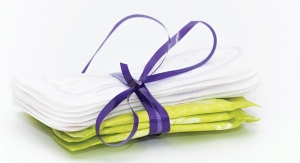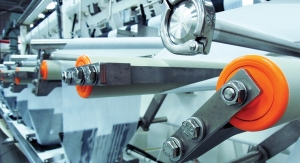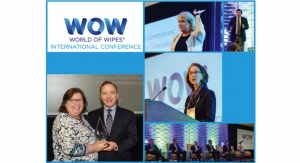Karen McIntyre, Editor11.10.17
The North American airlaid market is bracing itself for the start up of Glatfelter’s new airlaid line, the first significant investment the market has seen in more than a decade. Glatfelter will start running the line this month and is expected to start supplying the market in during the second half of the first quarter of 2018.
Glatfelter, one of the world’s largest airlaid producers, announced in early 2015, it would add a new lightweight production line in Fort Smith, AR, increasing its global capacity by 22,000 tons.
“There is a lot of unhappiness and concern in the North American airlaid market as to where that 22,000 tons of capacity is going to go,” says Phil Mango, industry consultant.
In announcing the new line, Glatfelter indicated that it was the result of a major industry order, and the plant’s Arkansas location, near existing plants of wipes manufacturers Rockline Industries and Kimberly-Clark, have left many speculating who those customers are.
Last month, Chris Astley, vice president of the company’s Advanced Airlaid business unit, told local stakeholders, his company has hired about 20 employees at the site in the past few weeks. Some of these employees have been visiting existing Glatfelter airlaid facilities in Gatineau, Quebec, Canada and Falkenhagen, Germany to familiarize themselves with the technology.
The investment is expected to bring 80 high tech manufacturing jobs to the Fort Smith, AR area. The site beat out about a dozen other locations to become Glatfelter’s next North American facility.
And, Glatfelter has been open about the technology planned behind the new line, saying that it will help it grow in lighter weight hygiene and disposable wipes products—a market already in growth mode, increasing 12% last year—was a priority.
In 2015, feminine hygiene applications dominated Glatfelter’s sales, representing 74%, while wipes comprised less than 10% of sales. CFO John Jacunski recently told analysts that the investment in Arkansas, which will also include a center of excellence, will allow Glatfelter to target wipes without compromising the needs of its feminine hygiene efficiencies.
“(The new line) will bring additional balance to the portfolio which is a good thing and at the same time sends a message to all of our customers that we are willing and able to support their growth,” he says.
North America has not seen significant airlaid investment since the early 2000s when Buckeye (which is now a part of Georgia-Pacific) added a 50,000-ton line in North Carolina around the same time that Concert Industries (a business now owned by Glatfelter) added its two side-by-side lines in Gatineau, Quebec.
What this new line will mean for the rest of the airlaid industry, particularly within North America, remains to be seen. As Glatfelter’s role in the wipes market expands, its main competitor Georgia-Pacific will likely be forced to look for new markets—like feminine hygiene or tabletop—to fill its capacity, much of which is made in Gaston, NC, on a line built by Buckeye Technologies in 2001. This line is now the best quality airlaid line for wipes in the world. It’s said to be the fastest, most cost efficient and offers a lot of advantages, Mango says.
“The newer line, which was added in 2001, is really optimized for making wipes and they have been very successful here,” he adds. “Glatfelter will really have to prove themselves, which they will. It is just a matter of how long that takes.”
What hangs in the balance, Mango feels, is older airlaid lines, like G-P’s Green Bay line which is several decades old. G-P could choose to idle this line but it offers a lot of advantages for industrial wipes applications. “Its probably more likely that G-P will focus on developing new applications,” Mango says.
North America’s other airlaid players, McAirlaids and Domtar, will not be as affected by the incoming lightweight capacity. McAirlaids has faced some challenges in its medical business and has focused on growing its role in businesses like food pads and private label underpads. Meanwhile, Domtar’s airlaid business is largely focused on absorbent core applications, which largely supplies its own personal care businesses.
Glatfelter, one of the world’s largest airlaid producers, announced in early 2015, it would add a new lightweight production line in Fort Smith, AR, increasing its global capacity by 22,000 tons.
“There is a lot of unhappiness and concern in the North American airlaid market as to where that 22,000 tons of capacity is going to go,” says Phil Mango, industry consultant.
In announcing the new line, Glatfelter indicated that it was the result of a major industry order, and the plant’s Arkansas location, near existing plants of wipes manufacturers Rockline Industries and Kimberly-Clark, have left many speculating who those customers are.
Last month, Chris Astley, vice president of the company’s Advanced Airlaid business unit, told local stakeholders, his company has hired about 20 employees at the site in the past few weeks. Some of these employees have been visiting existing Glatfelter airlaid facilities in Gatineau, Quebec, Canada and Falkenhagen, Germany to familiarize themselves with the technology.
The investment is expected to bring 80 high tech manufacturing jobs to the Fort Smith, AR area. The site beat out about a dozen other locations to become Glatfelter’s next North American facility.
And, Glatfelter has been open about the technology planned behind the new line, saying that it will help it grow in lighter weight hygiene and disposable wipes products—a market already in growth mode, increasing 12% last year—was a priority.
In 2015, feminine hygiene applications dominated Glatfelter’s sales, representing 74%, while wipes comprised less than 10% of sales. CFO John Jacunski recently told analysts that the investment in Arkansas, which will also include a center of excellence, will allow Glatfelter to target wipes without compromising the needs of its feminine hygiene efficiencies.
“(The new line) will bring additional balance to the portfolio which is a good thing and at the same time sends a message to all of our customers that we are willing and able to support their growth,” he says.
North America has not seen significant airlaid investment since the early 2000s when Buckeye (which is now a part of Georgia-Pacific) added a 50,000-ton line in North Carolina around the same time that Concert Industries (a business now owned by Glatfelter) added its two side-by-side lines in Gatineau, Quebec.
What this new line will mean for the rest of the airlaid industry, particularly within North America, remains to be seen. As Glatfelter’s role in the wipes market expands, its main competitor Georgia-Pacific will likely be forced to look for new markets—like feminine hygiene or tabletop—to fill its capacity, much of which is made in Gaston, NC, on a line built by Buckeye Technologies in 2001. This line is now the best quality airlaid line for wipes in the world. It’s said to be the fastest, most cost efficient and offers a lot of advantages, Mango says.
“The newer line, which was added in 2001, is really optimized for making wipes and they have been very successful here,” he adds. “Glatfelter will really have to prove themselves, which they will. It is just a matter of how long that takes.”
What hangs in the balance, Mango feels, is older airlaid lines, like G-P’s Green Bay line which is several decades old. G-P could choose to idle this line but it offers a lot of advantages for industrial wipes applications. “Its probably more likely that G-P will focus on developing new applications,” Mango says.
North America’s other airlaid players, McAirlaids and Domtar, will not be as affected by the incoming lightweight capacity. McAirlaids has faced some challenges in its medical business and has focused on growing its role in businesses like food pads and private label underpads. Meanwhile, Domtar’s airlaid business is largely focused on absorbent core applications, which largely supplies its own personal care businesses.







